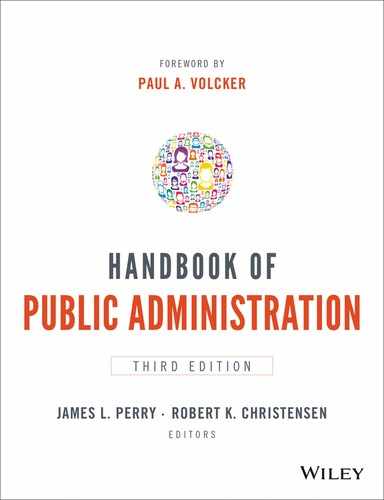Part 5
Developing Effective Administrative Systems
Part 5 focuses on resources—fiscal, information, and human resources—for effective government. The acquisition of these resources is a complex process embedded in a variety of factors, including the wealth of a political jurisdiction, trust relationships among stakeholders, and other variables peculiar to a particular resource. The first four parts of this book shed light on many of these factors, giving readers insights into the resource acquisition process. Part 5 examines the administrative systems associated specifically with fiscal, information, and human resources.
Budgeting and fiscal administration require public administrators to resolve a variety of operational, managerial, and strategic issues. At an operational level, public administrators are concerned with timetables and procedures used for budget development, the reliability of accounting procedures, security of cash collection methods, and proper methods for registering bonds. From a managerial perspective, they are concerned with how a budgeting system will help in making difficult choices among competing demands, the types of incentives a budgeting system creates for efficient use of resources, the types of budget information to collect, the efficiency of service delivery methods, the design of particular revenue sources, and the appropriate timing and size of bond issues. At a strategic level, public administrators are interested in how to acquire an adequate share of revenues for specific activities or programs, the soundness of the government's financial condition, the proper mix of revenues, and the appropriate amounts of short versus long term debt.
The resolution of these operational, managerial, and strategic issues is not purely or even primarily a technical matter. Budgeting and fiscal administration are technical and political processes. Decisions about trade-offs among programs and activities, the incidence of taxes, and time frames for paying for governmental services have significant political dimensions. The dual character of budgeting and fiscal administration is inescapable.
The first two chapters in part 5 illuminate both technical and political processes of budgeting and fiscal administration. In chapter 22 Alfred Ho examines one of the most important developments in budgeting as public entities have shifted from a focus on inputs and given more emphasis to performance. Budget formats and emphases have changed continuously during the course of the last century. Ho illuminates practices worldwide related to the operation, management, and effectiveness of performance-budgeting systems.
Next, in chapter 23, Yilin Hou provides fundamental information about the design, administration, and evaluation of government revenue systems. He identifies effective practices for the design and administration of revenue systems and accompanying criteria for their evaluation.
Unlike financial resources, citizens and analysts seldom see information resources in a budget. Financial resources are real, however, even though they are sometimes intangible. Public systems associated with information resources are critical for provision of public services and relations with stakeholders that often translate directly to the ability of governments to pursue their missions effectively. A government's information and communications technologies may also be vital parts of its ability to efficiently coproduce effective services and a high quality of life for its citizens.
The nature of information and information technology has changed radically since the previous edition of this book. As M. Jae Moon and Eric Welch observe in chapter 24, e-government is not the same as computerization, which has been a prominent part of government operations for a half-century. E-government involves use of information and communications technologies for government transactions with citizens, businesses, and other governments. Integrating technology and public service is nothing new. Early enthusiasm was fueled by promises of cost savings, improved customer and citizen service, and broader access. Moon and Welch provide some answers as to what extent these and other goals have been achieved and offer guidance about best practices going forward.
We have witnessed an explosion in the last decade of new forms of information resources. Ines Mergel seeks to capture in chapter 25 what we know about using social media effectively. She notes that public sector organizations are experimenting to discover applications for governance activities and establish the value proposition for social media in the public sector.
People comprise the third type of resource featured in part 5. Human resources are essential for governmental and quasi-governmental organizations to achieve their missions, and public administrators must strive to bring together the right mix of these capabilities to accomplish their missions.
Acquiring, developing and maintaining sufficient human resources to fulfill agency missions depends on a variety of factors, but one of the most important determinants is a jurisdiction's compensation system. Jared Llorens discusses in chapter 26 the successes of public compensation systems, their weaknesses, and the challenges that lay ahead. He looks to what we have learned from recent reforms and identifies the contours for future challenges.
Whether a government is resource rich or poor depends on a variety of considerations. Many of them may be unrelated to the wealth of the region in which a jurisdiction is located. Instead, the effectiveness of the administrative systems related to fiscal, information, and human resources may make a world of difference.
